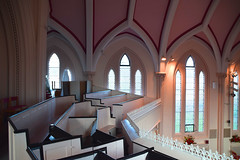| |
|
 |
|
It is a
historical curiosity that this little
town maintains two Anglican parish
churches - in fact three, if you include Melton St Andrew out on the western
edge of the urban area. Woodbridge St
John is a substantial boxy church of
1840, set at the top of its wide
churchyard in the 19th century part of
the town centre, about 300 yards from the
medieval parish church of St Mary. The architect was
John Clark, most famous for the grand
Italianate Ipswich Custom House, which he
had designed 20 years earlier. The cost was
£3000, about half a million in today's
money, which seems good value. The new
church gave the CofE extra capacity in
the town, although its main purpose was
probably intended as a mission church to
the terraced streets to the east of the
town.
|
One might think
that today there would be little use for such a
large Victorian church in such a small town,
particularly when nearby St Mary is so vast. Nothing could be
further from the truth. The church maintains its
tradition as a busy evangelical counterpart to
medieval St Mary's municipal High Church
grandeur. Almost everything inside was renewed in
the early 21st Century, but two notable earlier
survivals include the splendid angled west
gallery of the 1840s, and the late 19th/early
20th Century glass in the apse by ER Suffling.
The figures depicted are Samuel, Dorcas, St
Peter, St John, St James, St Andrew and Naaham's
wife's maid. The first and last remember young
children, the others various parishioners,
including members of the Hyne Edwards family, who
had provided the parish with its first vicar.
      
| St John
was an exercise in pre-ecclesiological
Early English, in Woolpit brick, like its
near-contemporary namesake at Bury St Edmunds. The new church
also gave the town centre the added
benefit of a new burial ground in the
days before the Cemetery Acts of the
1860s. The octagonal tower and spirelet
were taken down as unsafe in 1981, but
replaced in the early years of the 21st
Century thanks to a donor who felt that
the Woodbridge skyline lacked something
without it. You step inside beneath the
tower, which has been fitted out with
offices and a kitchen, through glass
doors into the nave. The old pews have
been removed, and replaced with modern
chairs. All the Victorian clutter of the
apse-like sanctuary has been cleared, and
the lancet glasses of saints look down on
a bright, open space. The nave and
sanctuary have been carpeted, and the
walls and roof painted in the cheerful
gothick style of the decades before the
church's construction. None of this has
destroyed the essential character of the
building. Rather, a transition to a space
serving new liturgical needs has been
managed in a creative, thoughtful and
interesting manner.
St John is
testimony to what a determined parish can
achieve. What is more, the church is open
every day.
|
|
 |
|
|
|

